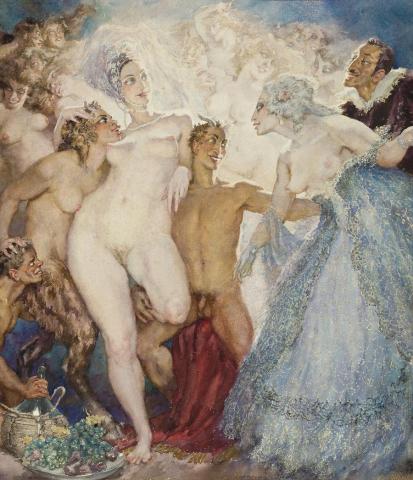TO THE ELECT, 1928
Norman Lindsay
watercolour on paper
69.0 x 60.5 cm
signed and dated lower centre: NORMAN LINDSAY / 1928, inscribed verso: To Rose / Norman Lindsay / 1928
Leonard Joel, Melbourne, 2 November 1995, lot 104
Private collection, Sydney
Company collection, Sydney
For Norman Lindsay, the elect were those who placed human beauty and sexual freedom foremost. He was the bitter enemy of the wowserism of his age and engaged all his prodigious talents to combat it. The raging controversies his paintings and prints aroused are now part of Australian art history; his pen drawing of Pollice Verso of 1904 in the National Gallery of Victoria causing such an outcry when exhibited that it was turned to the wall.
Bacchanalian fantasies, illustrations to the Memoirs of Casanova, Petronious' Satyricon, the fables and follies of the ancient Greek and Roman gods and goddesses, lusty pirates, Royalist cavaliers and their ladies were the stuff of his art. Bare bosoms, especially of ladies attired in elegant costumes of the eighteen century, appeared in his paintings almost as frequently as his signature. In both his art and life, Norman Lindsay celebrated the female figure. His wife Rose was for many years his chief model; his paintings frequently populated by her voluptuous figure and Junoesque looks. She was a goddess among women, acknowledged both in glorious nakedness or dressed in those period costumes that brought out the tantalising attraction of the female figure.
Lindsay peopled To the Elect, a male fantasy of enjoyable proportions, with some of his favourites. The characteristic central female figure, clad only in pearls and a lacy headdress, represents Venus, the goddess of love in all her glory. Pearls are one of her traditional attributes. She rests one arm on the shoulder of the central male figure, the face and horns on his head suggesting Pan, ancient god of the woods, personifying lust. Her right hand is on the head of an adoring female faun or satyr, likewise horned and of hairy animal legs and hooves. As satyrs spent their time lusting and carousing, Lindsay provided a flask of wine and grapes by her cloven hooves. All three look to the figures of Don Juan, the legendary womaniser, and his bare-bosomed lady in a dress of intricate laciness. The women show that classical whiteness of skin, the men traditionally tanned. The passion of Pan is highlighted by the splash of central red. Lindsay made a gift of this special painting to his own Venus, his wife Rose.
DAVID THOMAS
